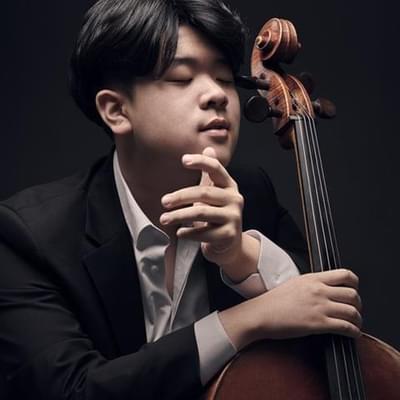Tchaikovsky 6

Full programme
- Smetana, Má vlast: Vltava (12mins)
- Tchaikovsky, Rococo Variations (19mins)
- Tchaikovsky, Symphony No.6 (Pathétique) (46mins)
Performers

Anna Rakitina
Conductor
Jaemin Han
Cello
Introduction
The single certain thing that is known about life - is that it ends. Among all the unreliability of our existence, this most defined knowledge has been irritating and frightening human minds since the beginning of time.
Music, as an art form, has been richly nourished by the fear of death - the only theme that might rival it is love - but these two have been well-connected in fact. As a core drama for every person, death has inspired a lot of composers, yet always sounded different. Take for example Bach’s propitiatory “Komm, süsser Tod”, or all genius “Requiems”, or Chopin’s second sonata. Music, in a way, is the most suitable way to talk about death as it doesn’t require words or explanations. This is why Tchaikovsky struggled to name his last symphonic work a “Tragic Symphony”, which would sound too plain in comparison with the musical context. He discussed it with his brother Modest, who while leaving Pyotr’s house, suddenly said:
– “Pathetique”
– “Bravo, Modia, Pathetique!” – was the reply.
Avoiding calling the thing by name, Tchaikovsky still gave a clear programme to his Symphony by hiding a quotation of an Orthodox song, “Rest Among Saints”, the chant that is always performed in church during Sunday services when the dead are commemorated. Hardly recognisable nowadays, back then it was probably as well-known as our “Happy Birthday”. The melody starts in the middle of the first movement’s development crash. Initially played by the trombones, it starts to deform into sighs and cries, giving away the deepest doubts of a canon belief in eternal life. A similar deformation happens with the very foundation of classical symphonic form – it was distorted by the strongest concept of a piece, where instead of traditional Allegro, “Pathetique” had to end with Adagio lamentoso.
To match the piece concept – neither will I search for cheerful words to conclude this introduction. As the poet said – “Believe your pain”, and so we do while diving deep into this music sorrow and living its grief.
Anna Rakitina
Conductor
Programme notes
Smetana’s Má vlast makes you feel like you’re strolling through the Czech countryside, taking in its beautiful castles, woods and fields. With the CBSO led by Anna Rakitina, Tchaikovsky’s Symphony No.6 aches with passion and sorrow, while the Rococo Variations are a delightful showcase for cellist Jaemin Han.
Vltava (from Má Vlast)
Bedřich Smetana (1824-84)
The museum to Bedřich Smetana in Prague is right next to the River Vltava, just upstream of the Charles Bridge, looking across to Prague Castle. Next door is a café, where tourists and locals sit admiring the riverside view and drinking ice-cold Pilsner. Smetana would have been delighted: long before he gave the Czech people their voice in music, he was a brewer’s son from Litomyšl. But it’s a wonderful illustration of just how central he is to Czech musical life and identity, even today.
Smetana’s epic cycle of symphonic poems Má Vlast (My Country) has become a national treasure, doing for the Czechs what Nimrod does for Britain and Finlandia for Finland. Vltava (1874) is the second piece in Má Vlast, and portrays the river which rises in the Šumava forest and flows through the Bohemian countryside and the city of Prague before joining the River Elbe. Two springs, portrayed by bubbling flutes, form the sources of the river, and these swiftly broaden into the main stream of the river itself, a surging string melody (once heard never forgotten). Hunting horns echo in the forests, before the river flows past a peasant wedding celebration - where the guests are dancing a jaunty polka.
Now night falls, and the moonlight shimmers on the river in magical orchestral colours. The music accelerates as the river crashes over the Rapids of St. John, above Prague, and finally sweeps through the Czech capital itself. The majestic theme of Vyšehrad, the great citadel and symbol of the Czech nation, towers over the closing bars, as the Vltava flows unstoppably onwards. With music this colourful, who needs a postcard?
Variations on a Rococo Theme, Op.33 (rev. Wilhelm Fitzenhagen)
Peter Ilyich Tchaikovsky (1840-1893)
When Tchaikovsky wanted to adopt musical fancy-dress and escape his modern-day troubles, he reached straight for his powdered wig. To say that Tchaikovsky admired Mozart is an understatement - he called him "the Christ of music". Measured, graceful, sunny, the master both of musical form and his own emotions, Mozart represented everything that Tchaikovsky longed to be. And the Mozart manner was a more presentable garb in which Tchaikovsky could converse with western musical friends. The German cellist Wilhelm Fitzenhagen never even learned to speak Russian, so it's unsurprising that when Tchaikovsky, in 1876, decided to write a work for him, he should do so in his most refined western musical language.
So he slimmed the orchestra down to classical size and built the whole piece from what he called a “Rococo” (or 18th century) theme, a poised little gavotte that might have been taken from a quartet by Haydn. But Tchaikovsky could run all he liked from his own musical personality – he couldn’t hide. Even considering that Fitzenhagen, rather ungratefully, re-edited the piece to suit his own taste (“That idiot!” declared Tchaikovsky) you'd need the ears of a pantomime donkey to mistake the Rococo Variations for an eighteenth-century work.
From the moment the woodwinds enter in the short, coaxing introduction, we're in the gentle, magical world of Tchaikovsky's ballets. The cello plays the “Rococo” theme, and then we're off on a sequence of seven variations, linked by sweet little orchestral asides. Some are playful games with the theme, lit by cello fireworks far beyond anything Mozart would have dreamed of. The last (which Tchaikovsky originally placed fourth) is a showstopping virtuoso finale. And two are the most heartfelt and unmistakably Russian laments imaginable. Imitation Mozart turns out to sound a great deal like first rate Tchaikovsky…
Symphony No.6 in B minor, Op.74 (Pathétique)
Peter Ilyich Tchaikovsky (1840-1893)
I. Adagio – Allegro non troppo
II. Allegro con grazia
III. Allegro molto vivace
IV: Adagio lamentoso
St Petersburg, 29th October 1893. Tchaikovsky’s Sixth Symphony has been premiered, without a name, the previous night. Now the score is to be sent to the engraver – and a decision has to be made. But neither “Tragic Symphony” nor “Programme Symphony” quite hits the spot.
“I left the room with Peter Ilyich still undecided” remembered Tchaikovsky’s brother, Modest “Then, suddenly, the word Pathétique came into my head. I returned, and I remember as if it were yesterday pronouncing the word as I stood in the doorway. ‘Brilliant, Modest, bravo – Pathétique!’ And in my presence he wrote the name on the score”. To Anglophone ears, “Pathetic” is an unfortunate title. But Tchaikovsky knew instantly that this was the perfect name for his most extraordinary, and most personal symphony: Symphonie Pathétique – literally, a “Symphony full of emotion.”
Three days later, Tchaikovsky fell ill. Four days after that, he was dead, at the age of 53 – officially of cholera. Immediately, rumours started – rumours that Tchaikovsky’s homosexuality was about to be exposed; rumours of poison, infected water, and secret honour-courts. Suddenly the Symphony became charged with significance. Why was its emotion so extreme – ranging from abysmal despair to delirious joy? Why did Tchaikovsky express it in such raw colour – pitch-black basses and bassoons, glittering piccolos and shrieking trumpets? And why, most of all, did it end not with a triumphant shout, but with a slow, painful descent into silence? It’s all too easy to hear the Pathétique as a musical suicide note. Yet whatever its content, this symphony is the work of a composer at the very height of his inspiration. “I consider it the best, and, in particular the most sincere of all my works” he told his nephew. “I love it as I have never loved any other of my musical offspring”.
No-one had written a symphony quite like this before -it’s almost as if Tchaikovsky is turning the form inside-out. A well-behaved classical symphony begins with a strong, confident first theme, only then turning to a gentler, less important “second subject”. Tchaikovsky’s first theme – after the Symphony has heaved itself painfully out of the darkness – is jittery, hesitant and awkward. But his second subject is quite simply one of the great melodies of all time – a huge, heartfelt song that stretches and languishes at glorious length. It returns at the end of the movement, before dying away to a quiet funeral march. In between becomes the most violent storm of emotion in all 19th century music – a volcanic explosion of rage, despair and pain, crowned by terrifying brass. The message is clear: what matters here is emotion, not form, and Tchaikovsky expresses his feelings with overwhelming power.
Next comes a waltz. Once upon a time, waltzes had meant happiness and escape for Tchaikovsky (think of the magnificent, celebratory waltzes that crown his great ballets Swan Lake, The Sleeping Beauty and The Nutcracker), but now something has broken; this one limps along, one foot missing, in an awkward 5 beats to a bar. The third movement is a march, and the composer of 1812 throws everything at it, each climax more dazzling – and noisy – than the last. After the tragedy of the first movement, and the uncomfortable calm of the second, the symphony finally seems to be on course for a happy ending - and for 114 years, audiences have broken spontaneously into applause at the end of the Allegro molto vivace.
And then the world falls in – as, with an anguished sob, Tchaikovsky pulls the floor out from beneath us. Something is terribly wrong. A slow finale? Those sobbing horns, those yearning strings, that final, fatal stroke of the gong and the last, broken chords…no symphony had ever ended quite like this. Surely no symphony was ever meant to end like this? It’s an extraordinary experience – and whatever they meant to him, Tchaikovsky asked only that we let the feelings in the music take us where they will. Once again – the clue’s in the title.
© Richard Bratby